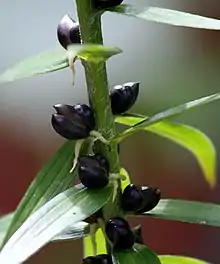| Lilium lancifolium | |
|---|---|
 | |
| Scientific classification | |
| Kingdom: | Plantae |
| Clade: | Tracheophytes |
| Clade: | Angiosperms |
| Clade: | Monocots |
| Order: | Liliales |
| Family: | Liliaceae |
| Subfamily: | Lilioideae |
| Tribe: | Lilieae |
| Genus: | Lilium |
| Species: | L. lancifolium |
| Binomial name | |
| Lilium lancifolium | |
| Synonyms[1] | |
|
Synonymy
| |
Lilium lancifolium (syn. L. tigrinum) is an Asian species of lily, native to China, Japan, Korea, and the Russian Far East.[1] It is widely planted as an ornamental because of its showy orange-and-black flowers, and sporadically occurs as a garden escapee in North America, particularly the eastern United States including New England,[2] and has made incursions into some southern states such as Georgia.[3]
It has the English name tiger lily, but that name has been applied to other species as well.
Description

Like other true lilies, the flowers are borne on upright stems that are 80–200 centimetres (31–79 inches) tall and bear lanceolate leaves 6–10 cm (2+1⁄2–4 in) long and 1–2 cm (3⁄8–3⁄4 in) broad. L. lancifolium produces aerial bulblets, known as bulbils, in the leaf axils.[4] These bulbils are uncommon in Lilium species and they produce new plants that are clones of the original plant.[2]
The flowers are odorless.[4] Each lasts a few days and if pollinated produce capsules with many thin seeds.[2]
Taxonomy
Varieties
.jpg.webp)
The names of names considered as varieties at some time are:
- Lilium lancifolium var. densum W.Bull
- Lilium tigrinum var. fortunei Standish
- Lilium tigrinum var. splendens Van Houtte
- Lilium tigrinum var. flore-pleno auct.
- Lilium tigrinum var. erectum G.F.Wilson
- Lilium tigrinum var. plenescens Waugh
- Lilium lancifolium var. flaviflorum Makino
- Lilium lancifolium var. fortunei (Standish) V.A.Matthews
- Lilium lancifolium var. splendens (Van Houtte) V.A.Matthews
The Lilium tigrinum flore pleno, the double-flowered variety, had been exported out of Japan by William Bull since 1869.[5]
Names
Scientific names
Botanists for many years considered L. tigrinum (after Ker Gawler[6]) the correct scientific name until it was determined that older name L. lancifolium (after Thunberg[7]) refers to the same species, and the latter became the accepted name.[2][lower-alpha 1]
Vernacular names
Its common name is tiger lily. Although this name is ambiguous across several species, it is correctly applied to this species alone.[2]
Cat toxicity
A case study of the successful treatment of a cat that ingested this particular species was published 2007.[8]
Uses
It is cultivated and wild foraged in Asia for its edible bulbs.[9] The cultivar 'Splendens' has gained the Royal Horticultural Society's Award of Garden Merit.[10] In Taiwan, both the flower and bulbs are used as food, as are the other related species: L. brownii var. viridulum, L. pumilum and L. candidum.[11]
Notes
- ↑ Under the rules of international botanical nomenclature, the older name takes precedence.
References
- 1 2 3 "Lilium lancifolium Thunb". Plants of the World Online. Royal Botanic Gardens, Kew. Retrieved 2021-03-01.
- 1 2 3 4 5 "1. Lilium lancifolium Thunberg, Trans. Linn. Soc. London, Bot. 2: 333. 1794.", Flora of North America, 26, p. 178. Tiger lily, lis tigré.
- ↑ Biota of North America Program 2014 county distribution map
- 1 2 Ohwi, Jisaburo (1965), Meyer, Frederick G.; Walker, Egbert H. (eds.), Flora of Japan, Washington, D.C.: Smithsonian Institution, p. 297, archived from the original on 2010-04-23 Alt URL
- ↑ Moore, Thomas; Paul, William, eds. (1873), "A Beautiful Flower and Farm and Garden", The Florist and Pomologist: 15–16
- ↑ Ker Gawler, J. G.; Bellenden, John (1809) "Lilium tigrinum, Tiger-spotted Chinese lily". Botanical Magazine 31: plate 1237ff.
- ↑ Thunberg, Carl Peter (1794), Transactions of the Linnean Society of London 2: 333 (in Latin)
- ↑ Berg, Rebecca IM, Thierry Francey, and Gilad Segev (2007) "Resolution of acute kidney injury in a cat after lily (Lilium lancifolium) intoxication". Journal of Veterinary Internal Medicine 21(4), pp. 857–859.
- ↑ Dai Nihon Nōkai [in Japanese] (1895). Useful Plants of Japan Described and Illustrated. Agricultural Society of Japan. p. 27.
- ↑ "RHS Plant Selector - Lilium lancifolium 'Splendens'". Archived from the original on 15 May 2013. Retrieved 26 June 2013.
- ↑ "可供食品使用原料彙整一覽表". Archived from the original on 2014-01-26. Retrieved 2014-01-25.
Bibliography
- Shimizu, Moto'o (1947). "Oni-Yuri (Lilium lancifolium Thunb.)". Lily Yearbook. North American Lily Society (7): 55–.
